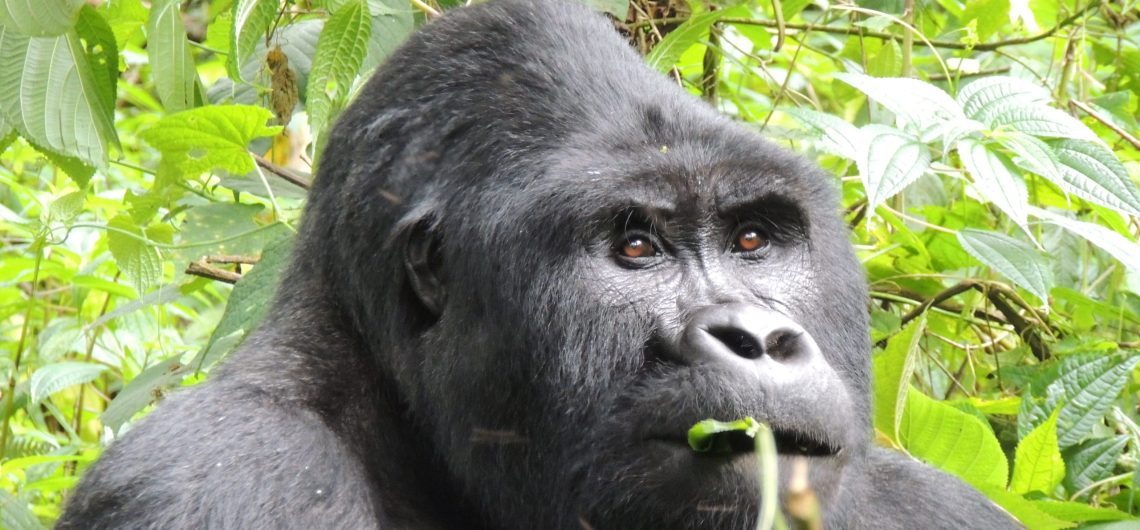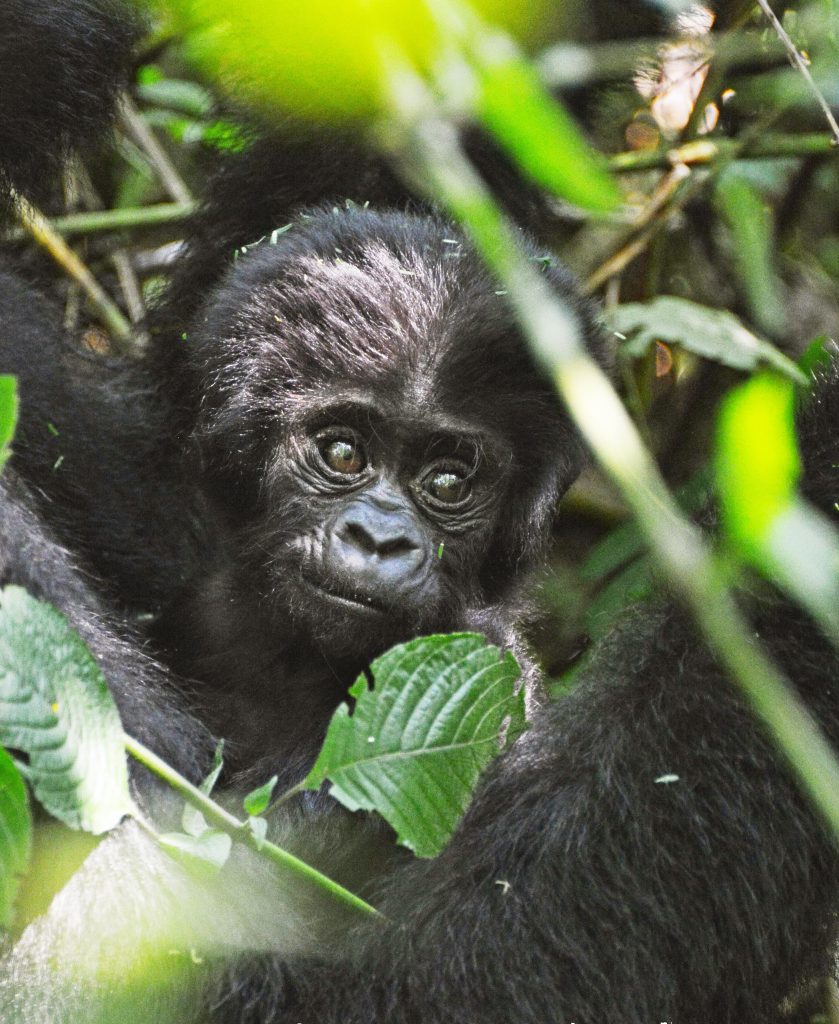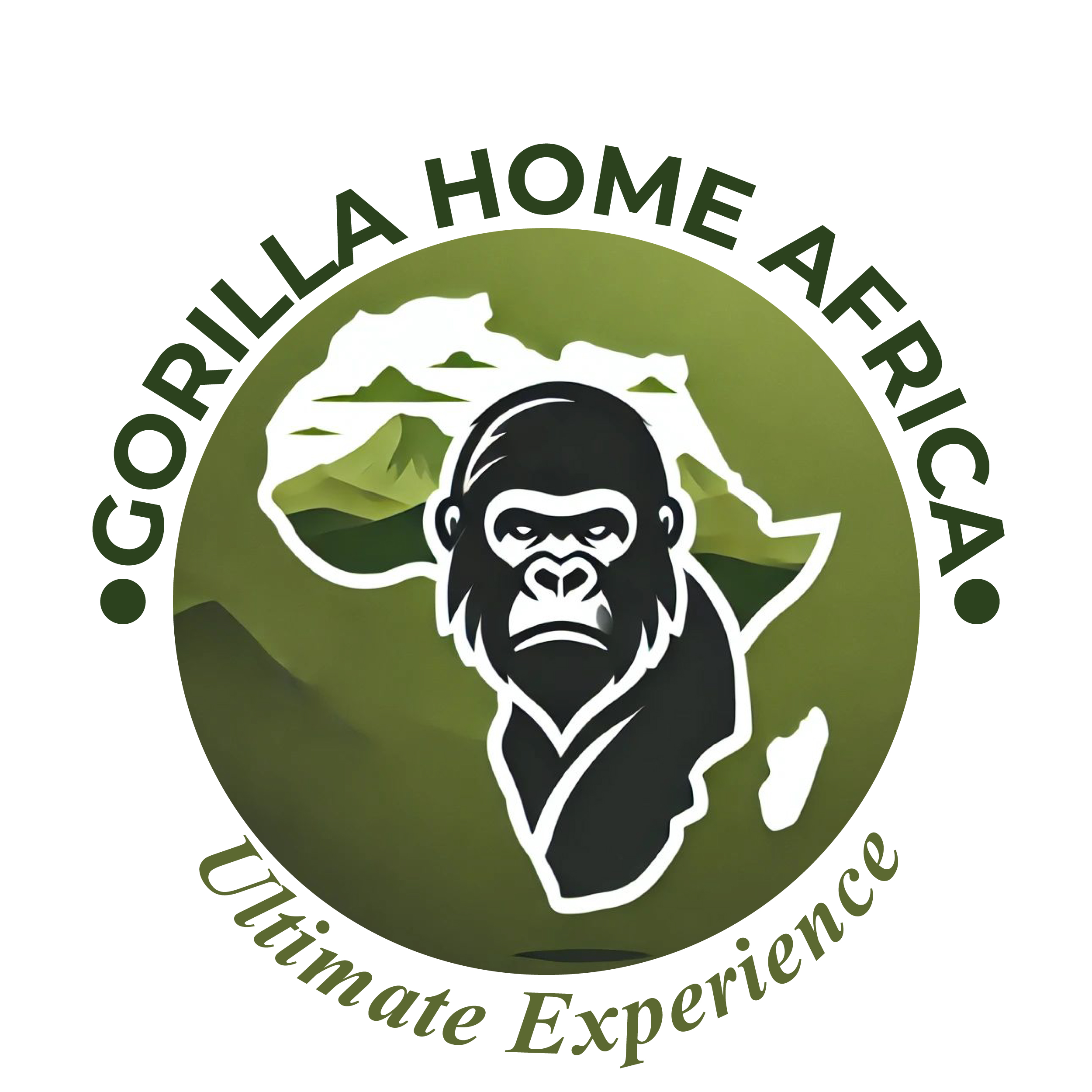
The Republic of Rwanda is a landlocked country in Central Africa’s Great Rift Valley, where Africa’s Great Lakes region intersects with Southeast Africa. Bordered by Uganda, Tanzania, Burundi and the Democratic Republic of the Congo, Rwanda’s geography is dominated by mountains, savanna and numerous lakes. Located a few degrees south of the Equator, Rwanda’s quilt-like topography and highly elevated position have given it the nickname, ‘land of a thousand hills’.

Why Go to Rwanda?
Africa’s Most Accessible Gorilla Trekking Destination
The country’s greatest tourist attraction – and arguably the most compelling wildlife encounter on Earth – is gorilla trekking in Rwanda ‘s montane rainforests. These close encounters with small families of the world’s last surviving mountain gorillas leave lasting impressions on every visitor to Volcanoes National Park in Rwanda. There are only about 900 mountain gorillas left on Earth and trekking into their native forests is the only way to see these critically endangered animals, as they cannot survive in captivity.
Rwanda delivers Africa’s most accessible gorilla trekking experiences – Volcanoes National Park lies only 80 kilometres (50 miles) from Kigali International Airport. If you are visiting Rwanda and have limited time, then this is where to see gorillas in Africa. You can simply land in Kigali, be driven to your lodge, trek the next day and leave for the airport the following morning, making it possible to wrap up your gorilla trekking trip in five days or less.
Track Chimpanzees & Other Primates
Although gorilla trekking is one of the biggest Rwanda tourist attractions, there are plenty of other primate trekking experiences to enjoy when visiting Rwanda. Nyungwe Forest National Park is home to thirteen different primate species (about a quarter of all Africa’s primates), including chimpanzees and Rwenzori colobus monkeys.
Located in the southwest corner of Rwanda, Nyungwe Forest National Park is an expansive and untouched tropical rainforest with a tall, thick canopy. Spreading over 1,000 square kilometres (385 square miles), Nyungwe Forest harbours the biggest area of remaining montane forest in East or Central Africa. It’s home to about 310 bird species, over 75 different species of mammals, and hundreds of butterflies and orchids. Nyungwe’s misty hills echo with the calls of chimpanzees and birdsong, a place of spectacular biodiversity and the quintessential tropical rainforest.
See the Big 5
The country may not always be an obvious choice for a ‘classic’ safari but if you are visiting Rwanda for gorilla trekking, then augmenting your trip with a safari in Akagera National Park is well worth considering. With its savannah plains, lakes, papyrus swamps, rolling hills and gaping valleys, Akagera is scenically one of the prettiest parks in Africa.
Akagera is home to the biggest protected wetlands in Central Africa and about 8,000 animals. In 2015, lions were released in Akagera National Park, followed by Eastern black rhinos two years later. These successful reintroduction programmes made Akagera a celebrated Big 5 safari destination for the first time in almost 20 years. Today, Akagera is managed in partnership with African Parks, a non-governmental conservation organization, which has made a very positive impact on life in this beautiful safari park.
Explore One of Africa’s Cleanest & Most Inspiring Cities
Rwanda is a frontrunner in creating a single-use plastic-free Africa. A shining star on the continent, the country instituted a national ban on non-biodegradable plastic bags in 2008. Rwanda also introduced a universal service called Umuganda, a community clean-up project on the last Saturday morning of each month when citizens get together to help keep the streets clean, tend to gardens and assist their neighbors.
When visiting Rwanda, you’ll most likely need to spend a night or two in its modern and spotlessly clean capital, Kigali. It’s a beautiful city that sprawls across countless hills, ridges and valleys, with a vibrant restaurant and nightlife scene. There are also numerous shopping malls in the city centre, featuring some chic boutiques and quaint coffee shops. And if you’re looking for something more authentic during your vacation in Rwanda, then head to one of Kigali’s many lively and genial markets.
The city’s State House Museum and the Natural History Museum are both worth a visit if you are staying in Kigali. But perhaps one of the best-known Rwanda landmarks is the soul-stirring Kigali Genocide Memorial. This insightful monument presents the history preceding the genocide in the country, helps to give context to the origins of the genocide, and recognises just how far Rwanda has moved on in the intervening years.
Where to Go in Rwanda
Volcanoes National Park: ‘Gorillas in the Mist’ Country
Arguably the most famous of all Rwanda tourist attractions is the stunning Volcanoes National Park, the country’s flagship reserve. It covers 160 square kilometers (62 square miles) of prime rainforest, encompassing five of the eight volcanoes in the Virunga Mountains range. It’s a mystical backdrop for life-changing gorilla trekking adventures – no other wildlife encounter on Earth compares with the experience of spending time with a family of mountain gorillas in their natural habitat.
Guided by experienced gorilla trackers through the park’s towering African redwoods, bamboo, weaving vines and flowering lobelias, Volcanoes offers some of the best gorilla trekking expeditions in Africa. The park was also the base for pioneering primatologist Dian Fossey – you can pay your respects at Fossey’s grave and even enjoy immersive gorilla conservation experiences with the Dian Fossey Gorilla Fund.
Volcanoes is a well-protected and monitored reserve chock-full of monkeys (including the rare golden monkey) and forest birds. When visiting Rwanda, a percentage of your travel spend goes to community projects around the park, reinforcing the positive impact of gorilla trekking in Volcanoes and making conservation of these great apes meaningful to rural communities in a very practical way.
Nyungwe Forest National Park: Scenes from a Fairy Tale
Nyungwe Forest National Park is a colossal tropical rainforest that includes the biggest strip of remaining montane forest in Central or East Africa. It’s home to a plethora of bird, butterfly and orchid species, as well as about a quarter of all Africa’s primates.
The heart of Nyungwe is like a scene from a fairy tale. Ancient mahogany and ebony trees tower above you, gorgeous orchids cling to every branch, and colourful birds and butterflies flit around while you quietly follow the calls of primates.
Primate safaris are among the top Rwanda tourist attractions, and Nyungwe is the ideal destination for these tracking experiences. With 13 different primate species living in Nyungwe Forest, trekking in search of chimpanzees, Rwenzori colobus monkeys, l’Hoest’s monkeys, and the grey-cheeked mangabey are among the many highlights in this spectacular rainforest.
Best Things to Do
There are over 130 kilometres (80 miles) of hiking routes in Nyungwe Forest National Park, which allow visitors to explore its magical interior and enchanting habitats with expert guides. And walking in Nyungwe is magnificent!
Although the Igishigishigi Trail is one of the shortest hikes in the park, it features the highest canopy walk in East Africa: a metal bridge suspended 50 metres (164 feet) above the forest! It’s not for the faint-hearted but if you want to get a real sense of the sheer scale of Nyungwe Forest, it’s one of the most unique experiences you can have when visiting Rwanda.
Akagera National Park: A Conservation Success
Akagera National Park covers about 1,120 square kilometres (432 square miles) and is one of the oldest national parks in Africa – it was first gazetted in 1934. The park endured a troubled period in the late 1990s when its ecosystems were harmed by cattle-grazing and poaching in consequence of Rwanda’s civil war.
But today, Akagera is managed in partnership with African Parks, a non-governmental conservation organisation which has made a very positive impact on the park’s animal populations. Thanks to various anti-poaching measures and the reintroduction of lions and rhinos, Akagera National Park is well on its way to being restored.
Akagera boasts a beautiful blend of low-lying grasslands and savannah plains, rolling hills and valleys, as well as a series of lakes, marshes and papyrus swamps that make up the biggest protected wetlands in central and eastern Africa. This extremely diverse variety of habitats make Akagera a very pretty park.
When you’re visiting Rwanda and enjoying a safari in Akagera, you are most likely to see the usual plains species like impala, topi, eland, giraffe, waterbuck, sable, roan and zebra. Hippo, crocodile, buffalo and elephant are also commonly spotted on game drives. And thanks to the successful reintroduction of lion and rhino, Akagera is also home to the Big 5. Leopards are present but a little trickier to spot – no matter where you are on safari – because of their mastery of camouflage and stealth.
If you are a keen birdwatcher, then a safari in Akagera will float your boat. It’s a birdwatcher’s paradise of over 480 species! Raptors and savannah birds are common, as well as numerous endemic species like the red-faced barbet. Plentiful waterbirds like African fish eagles, open-billed storks, cormorants, herons, and crowned cranes can also be spotted on boat cruises in Akagera’s lakes. And if you are very lucky, you might even get a glimpse of the peculiar and prehistoric-looking shoebill, also known as ‘whalehead’.
Kigali: A Modern & Uplifting Capital
Kigali is the country’s entry and exit point for gorilla trekking safaris. When visiting Rwanda, you will usually fly into Kigali International Airport and, depending on your itinerary, either transfer straight to Volcanoes National Park (about 80 kilometres or 50 miles) or overnight in the safe, attractive and surprisingly neat Kigali. Most tourists utilise Kigali as a quick stopover before and after a gorilla trekking adventure but if you have a couple of days to spare while visiting Rwanda, it’s a wonderful city to explore. Kigali sees relatively low tourist numbers, so if you do take the time to traverse the city, you’ll be rewarded by warm interactions with the friendly locals and a fantastic insight into Rwanda.
One of the most important Rwanda tourist attractions is the poignant Kigali Genocide Memorial. Standing amid gorgeous rose gardens and water fountains, the memorial presents the history preceding Rwanda’s 1994 genocide, helps to clarify the reasons for this devastating massacre, and recognises just how much healing and recovery the country has gone through in the intervening years. If you are visiting Rwanda for the first time, the memorial is an essential stop that will leave a lasting impression.
Other museums in the city that are well worth a visit are the State House Museum and the Natural History Museum. Kigali also boasts a fantastic selection of contemporary shopping malls, a vibrant café and bar culture, authentic and lively markets, and hotels that are of a good international standard.
Best Things to Do
Visit the Kigali Genocide Memorial.
Browse for curios and souvenirs at the Caplaki handicrafts cooperative.
Stop at the Kigali Cultural Village for live music and art workshops.
Sample delicious fair-trade coffee at the Hingakwa Women’s Coffee Cooperative.
Lake Kivu: Africa’s Sixth Largest Lake
The western side of Rwanda is enclosed by Lake Kivu, one of a series of massive freshwater lakes that lie along Africa’s Great Rift Valley. Considered a hidden gem among the Rwanda tourist attractions, the real joy of the Lake Kivu region is driving between its towns – the road gently twists back and forth as it zigzags through the gorgeous hills and mountains beside the lake. It’s a fantastic option if you want to take an unhurried route between Nyungwe Forest and Volcanoes National Parks, stopping over to enjoy Lake Kivu’s immaculate beaches and warm, safe swimming waters.
Best Things to Do
While visiting Rwanda, we recommend spending a couple of days in Gisenyi, a large town that’s spread over various hills on Lake Kivu’s northern edge. Once a well-known colonial beach resort, Gisenyi’s lakeside is lined with old mansions, trendy bars ideal for sundowner cocktails, and a few hotels of international standard.
When to Go to Rwanda
The best time to visit Rwanda is between June and September, the country’s dry season. This time ofthe year has the most comfortable climate for gorilla trekking in Volcanoes National Park, a safari in Akagera, and the lowest risk of malaria. It is possible to hike to see mountain gorillas at other times in the year, but bear in mind that it may be more difficult due to rainfall as well as steep and muddy paths.
When visiting Rwanda during January and February, the high and medium-altitude areas like Kigali, Lake Kivu, Volcanoes, and Nyungwe are hot in the day but cool in the evenings. Low-lying regions like Akagera National Park are hot in the day and warm in the evenings. This is a good time to go on an Akagera safari and a great opportunity to take in the breath-taking scenery of Rwanda. This is also a good time for gorilla trekking, although it can get a little more humid than the June to September period.
